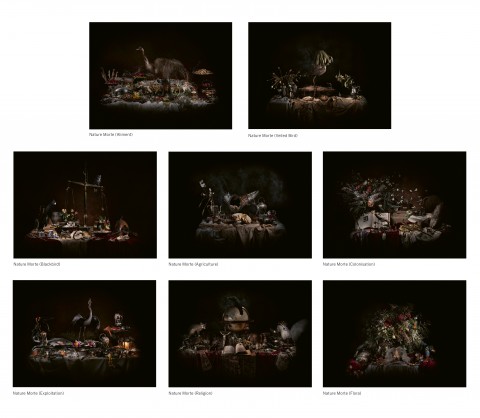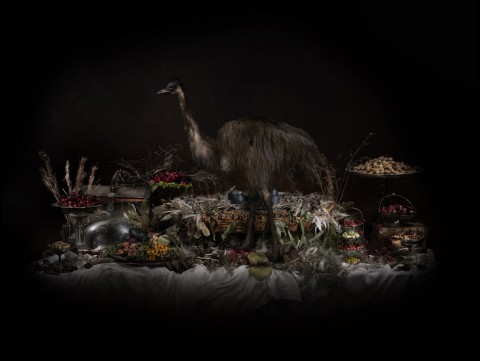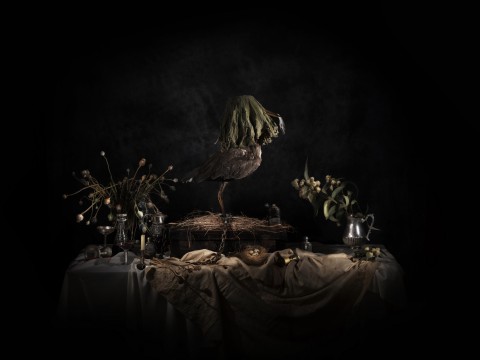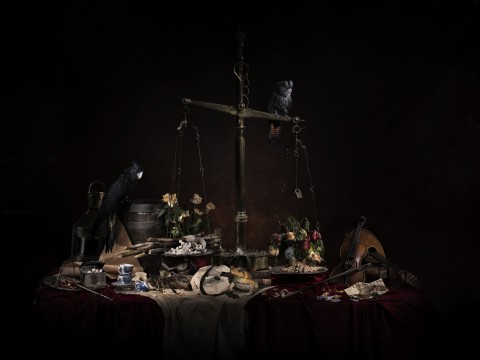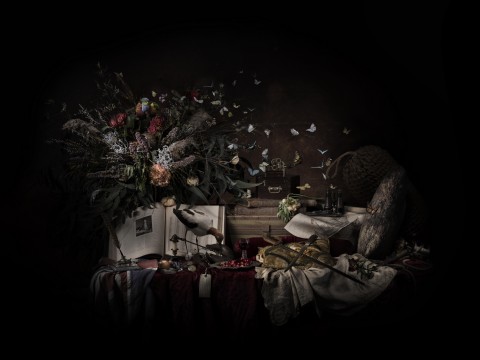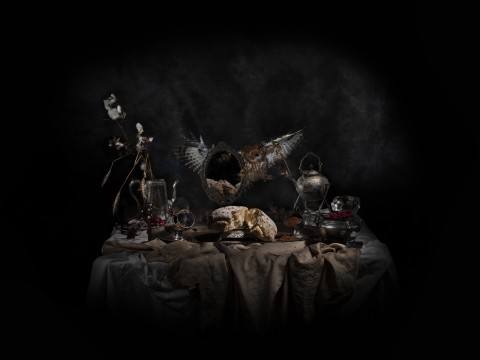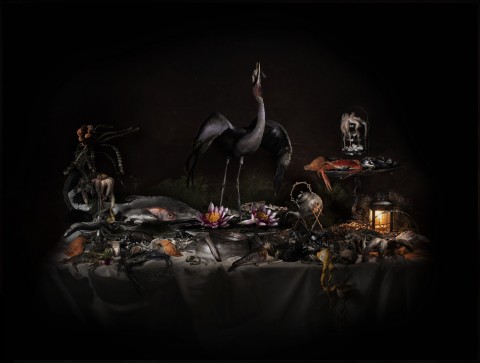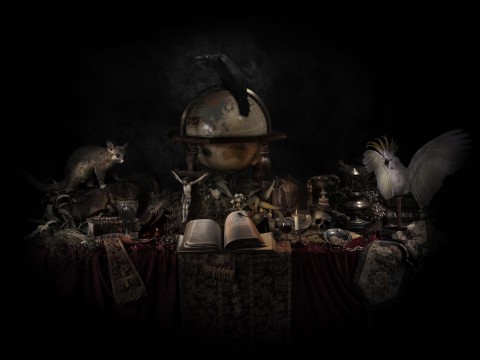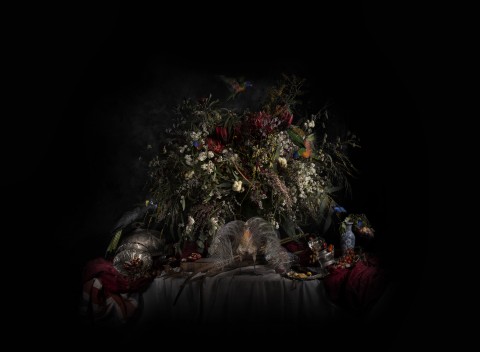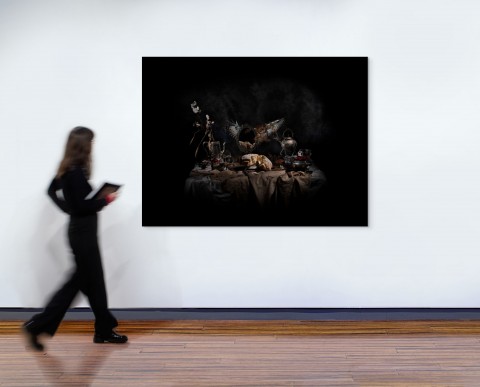NATURES MORTES, 2021
MICHAEL COOK
suite of 8 inkjet prints on canvas
140.0 x 200.0 cm (each)
each signed, numbered and inscribed with title on artist’s stamped label verso
Private collection, Brisbane, acquired directly from the artist in 2021
Natures mortes, Andrew Baker Art Dealer, Brisbane, 17 March – 1 May 2021 (another example)
Natures mortes, Living Country, Deletaille Gallery, Brussels, Belgium, 11 February – 28 May 2022 (another example)
MICHAEL COOK : NATURES MORTES, Noosa Regional Gallery, Queensland, 16 July – 4 September 2022 (another example)
HOTA Collects: Punching Up | 21st Century Indigenous Photography, HOTA Gallery, Gold Coast, Queensland, 19 October – 20 November 2022 (another example)
Still Life Now, Queensland Art Gallery | Gallery of Modern Art, Brisbane, 24 September 2022 – 19 February 2023 (other examples of Nature Morte (Agriculture) and Nature Morte (Blackbird))
Another example of this suite is held in the collection of HOTA Gallery, Gold Coast, Queensland
Other examples of images from this suite are held in the collections of Queensland Art Gallery | Gallery of Modern Art, Brisbane, and Yarilla Arts and Museum, Coffs Harbour, New South Wales
Brisbane-based artist Michael Cook’s photographic works, always sumptuously presented and carefully staged, address personal and socio-political issues of post-colonial identity in Australia. The figurative works which brought him critical acclaim early in his career – Undiscovered, 2010; Civilised, 2013; Majority Rule, 2014; Object, 2014, and Invasion, 2017 – oscillated between different cultural perspectives and introduced surreal and imaginary imagery in order to disarm and amuse viewers. The recent Natures Mortes, 2021 presents a departure from this technique, concealing behind its polished traditional veneer an incisive and mournful perspective on the cumulative devastation wrought by Australian colonisation. Produced in the midst of rolling COVID pandemic lockdowns where life stood still, Cook’s suite of eight Natures Mortes are dense allegorical tableaux whose stillness and glistening penumbra lure the viewer to slowly consider the incongruous objects and their relationships – unlocking multiple layers of symbolic social commentary.
In Natures Mortes, Michael Cook borrows artistic conventions from 17th century Europe and applies these to bountiful and dramatically lit arrangements of native Australian flora and fauna. The term Natures Mortes is borrowed from French, designating the artistic form of still life with the literal meaning of ‘dead nature’. Cook appropriates the aesthetic codes of Golden Age Dutch still life painting funded by pre-industrial and colonial expansion, where painters warned in their vanitas and memento mori paintings of the perils of greed and pride, and the inevitable transience of life. Now, over two hundred years later, and from an opposing post-colonial perspective, Cook reuses these stylistic codes to address similar, updated social issues, addressing them in separate individual vignettes: climate responsibility, biodiversity, religion, addiction and natural resource depletion.
Exploitation’s mouth-watering display of oil-slicked seafood, inedible for the native heron in the centre of the composition, addresses an unsustainable depletion of fossil fuels and its environmental implications. Colonisation, however, is more literal in its symbolic accoutrements of the European age of enlightenment (books, maps, inkwell, swords, spy glasses), which the artist has juxtaposed with a damaged shield standing in for the lost Gweagal shield, witness to violent encounters at the British landing in Botany Bay.1 Agriculture, in its arid and beige arrangement, shows the damage caused by land reclamation and unsustainable farming practices upholding the false god of a baked loaf of bread. Around this central image introduced predators and pests like the barn owl, beetles and mice feast on broken blades of native Kangaroo Grass. The influence of Bruce Pascoe’s 2014 book, Dark Emu, detailing the misconceptions about indigenous agricultural land management is perceptible in this image, and quotes from the text were reprinted in the catalogue essay for first exhibition of Natures Mortes at Andrew Baker Gallery. Blackbird is a devastating memento mori, recounting the practice of ‘blackbirding’: the entrapment, lured by music, of South Sea Islanders who were forced into indentured servitude in the burgeoning sugar Queensland plantations of the 18th and 19th century. Veiled Bird, shrouded with the leaves of the dried native lily, abandons her glistening eggs, waylaid by the temptations of substance abuse, symbolised by the broken poppy stems, a snuffed out candle and mysterious phials lurking on the edges of the velvety darkness.
Using his twenty years’ experience as a commercial fashion photographer to orchestrate each of these stylised table-top cornucopias, Cook populates these still lives with native fauna, in heroic positions in the centre of each image. Under the auspices of Artspace’s collaborative project 52 Actions, Cook presented a 23 second time-lapse video of the creative process of the studio photography Blackbird, Flora, Aliment.2 In it, we can deduce that the animals within Blackbird (red and yellow-tailed black cockatoos and a cane toad) and Aliment (an emu), were not physically present in either a live or taxidermised form, but were masterfully digitally introduced into the image in post-production.
Natures Mortes is reported to have been Cook’s most successful body of work to date, with all three edition sizes sold out.3 The works are well represented in Cook’s home state of Queensland, with examples acquired by the Queensland Gallery of Modern Art and a full suite acquired by the new HOTA Gallery at Surfers Paradise. Significantly, Veiled Bird, was also the winner of 2021 acquisitive National Still Life Award at Yarilla Art and Museum, in Coffs Harbour.
1. Fairley, G., ‘Exhibition Review: Michael Cook Natures Mortes at Andrew Baker Art Dealer (QLD)’, ArtsHub, 7 April 2021
2. 52 Actions, Artspace, Sydney, 2021; see https://www.artspace.org.au/52-actions/52-actions/michael-cook (accessed February 2024)
3. Hawkins, S., ‘Michael Cook’, Head On Foundation Magazine, 26 November 2021: see https://headon.org.au/magazine/michael-cook (accessed February 2024) and Michael Cook, Natures Mortes at https://www.michaelcook.net.au/projects/natures-mortes (accessed February 2024)
LUCIE REEVES SMITH
